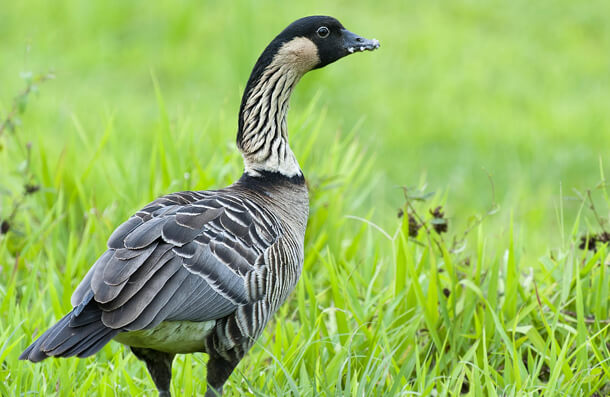New Study Identifies Sources of Mortality for Iconic Hawaiian Goose
Contact: Robert Johns, 202-888-7472, Email click here

Hawaiian Goose, Owen Deutsch
(Honolulu, Hawai‘i, July 23, 2015) Leading mortality causes for one of Hawaiʻi's most iconic birds, the federally endangered Hawaiian Goose or Nene, have been identified by researchers at the U.S. Geological Survey (USGS).
The most common cause of death for the rare bird was starvation, followed by trauma from vehicular strikes and predation, as well as diseases, among which toxoplasmosis (an infection caused by a parasite associated with cats) predominated.
Behind the Study: Causes of Nene Mortality
The four researchers, who published their findings in the Journal of Wildlife Diseases, are from the USGS National Wildlife Health Center Honolulu Field Station. In their study, they systematically examined Nene carcasses between 1992 and 2013.
Of 300 birds examined, causes of death were found to be as follows:
- Emaciation (24%),
- Trauma and disease (23% each),
- Poisoning (4%), and
- Miscellaneous (2%), with the remainder unknown.
Gosling carcasses were found most frequently (45%), followed by adults (38%), immatures (15%), and birds of unknown age.
For adult birds, trauma (38%) caused by human-related factors such as vehicle impacts and predation by introduced mammals (e.g., mongooses, dogs) was the leading cause of mortality.
Eighty percent of carcasses examined had been free-ranging birds, with females slightly outnumbering males. Most birds originated from the island of Maui (38%), followed by Kauaʻi (30%), Hawaiʻi (22%), and Molokaʻi (10%). There was a marked increase in numbers of birds submitted after 2005 for reasons that are currently unclear, but possibilities might include increased awareness for reporting or increased numbers of Nene.
Guidance for Nene Management
According to the study, determining causes of death in endangered birds in tropical ecosystems can be challenging because these animals are inherently uncommon in the wild. Sample sizes are small and decomposition is rapid, making it difficult to retrieve specimens suitable for laboratory diagnostics.
“Understanding causes of death can aid management and recovery of endangered bird species such as the Nene,” said lead author Thierry M. Work. “For example, human-related mortality sources often can be reduced with effective management programs. The use of road signs and enforcement of speed limits can certainly reduce incidents of trauma, whereas T. gondii [toxoplasmosis] infections can be mitigated with feral cat control efforts.
“Such approaches would seem reasonable given the long-standing cultural importance of the Nene to the state of Hawai‘i and the bird's precarious population status,” he continued.
“The gradual recovery of the Nene is a heartening success story in the history of Hawaiian bird conservation,” said Dr. George Wallace, Vice President for Oceans and Islands at American Bird Conservancy. “But as this study illustrates, there are still persistent threats to the species, and the Nene will not likely survive without ongoing active management. This study points wildlife managers in some concrete directions.”
Decline of the Nene in Bird Extinction Capital
The Hawaiian Islands have the highest number of endangered birds of any U.S. state, and the Nene is one of the most charismatic and visible. It is the largest surviving native terrestrial bird in the Hawaiian Islands and is the official state bird.
During the 18th century, numbers of this bird statewide may have been as high as 25,000, but those numbers declined to fewer than 50 individuals by the 1940s.
Hunting, habitat loss, and introduced predators have contributed to the decline of Nene, particularly in coastal lowlands, where habitat alterations have been most pronounced. In 1949, captive breeding programs were started to recover the species. These programs ended in 2011, and numbers currently fluctuate at approximately 2,000 birds statewide.
Recently, populations have increased somewhat, but the birds are restricted primarily to the islands of Hawaiʻi, Kauaʻi, Maui, and Molokaʻi. One pair has become established on Oʻahu in recent years.
Although genetic diversity of Nene is lowest on Kauaʻi, populations on that island are thriving, probably because of the absence of mongooses, an introduced predator, and because of the greater availability of lowland habitat where Nene reproductive success is greater.
#
American Bird Conservancy is the Western Hemisphere's bird conservation specialist — the only organization with a single and steadfast commitment to achieving conservation results for native birds and their habitats throughout the Americas. With a focus on efficiency and working in partnership, we take on the toughest problems facing birds today, innovating and building on sound science to halt extinctions, protect habitats, eliminate threats, and build capacity for bird conservation.


















































